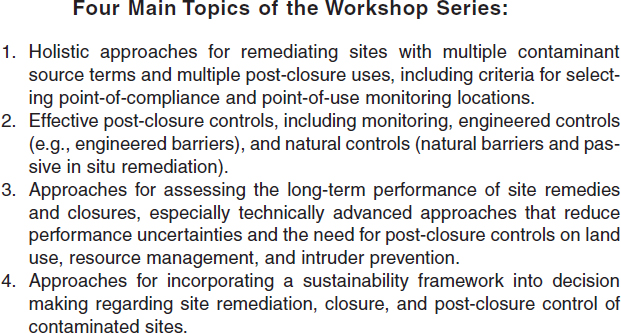6
Summary of the Workshop Series Goals
To close the workshop, William (Bill) Levitan (Office of Environmental Management) re-introduced the goals and objectives of the workshop series and asked for perspectives from the attendees. The discussion was guided by the re-introduction of the topics outlined within the statement of task (see Figure 6-1). Participants were asked to comment on how well the topics were addressed by the workshop and whether best practices had been identified. Because a significant percentage of the participants had attended both workshops, these attendees were asked to tailor their comments to include both workshops.
The following comments are grouped by the bulleted topics in Figure 6-1.
TOPICS 1 AND 2
Planning committee member Patricia Culligan (Columbia University) noted that the first bullet shown in Figure 6-1 should include monitoring beyond environmental conditions—as Paul Black had suggested earlier. Economic and social considerations should also be monitored through new metrics.
Carol Eddy-Dilek (Savannah River National Laboratory) supported functional monitoring over compliance monitoring as a best practice for establishing in situ monitoring locations. Compliance monitoring will not provide the information that is needed to make decisions for complicated sites (e.g., sites with multiple contaminant sources).

FIGURE 6-1 The four main topics of the workshops as outlined in the statement of task (see Appendix A).
SOURCE: Levitan 2014.
TOPIC 3
For the third bullet, Dr. Culligan noted that a clear and reasonable definition of “long-term” is needed. Fifty to 200 years is reasonable, but millions of years is not practical. Dr. Culligan suggested that EM should determine at what timescale sustainability approaches should be applied (e.g., life cycle analysis).
Dr. Culligan identified Dave Geiser’s example of continued public engagement after a site has been closed as a best practice. As a post-closure activity, one must be prepared to encourage public involvement in the site. For example, if the public actively uses the site for recreation, wildlife, or industry, then it must be comfortable with the effectiveness of the remedy.
Several workshop attendees noted that public perception is strongly affected when classified information is redacted from documents. Roger Petrie provided an example: the K25 project at Oak Ridge Reservation (ORR) had redacted information, which had very little impact on the final remedy but did impact how the deactivation and decommissioning took place, largely because of the public’s unease with missing information. Bill Levitan noted that from EM’s perspective, little information should be restricted from public access. Dave Geiser commented that LM does not store classified information, but several staff members hold clearances that allow access to classified nuclear test information, which is needed to confirm remedies are working.
Carol Eddy-Dilek highlighted DOE’s Legacy Management data man-
agement system, the Geospatial Environmental Mapping System (GEMS),1 as a best practice for data transparency and for assessing and monitoring long-term remedy performance. All Department of Energy (DOE) sites should save/release information in a similar way by moving remediation data to a more open, accessible system.
TOPIC 4
Craig Benson (University of Wisconsin) suggested that to include sustainability concepts into the broader context of EM’s decision-making process, the last bullet in Figure 6-1 should be moved to the top. A “reset” of regulations and regulatory approaches has been suggested as a way to adopt disruptive—as opposed to incremental—change. Rethinking the current regulatory strategy while balancing options in a transparent way (as suggested by the last bullet) may be needed as the nation becomes increasingly resource constrained.
Bill Levitan (DOE EM) supported the idea of moving this bullet to the top of the list because it would address a recent Executive Order directing agencies to identify additional risks that climate change introduces and to develop a suitable governmental response.2
______________
1 See http://gems.lm.doe.gov/imf/sites/gems_continental_us/jsp/launch.jsp.
2 See http://www.whitehouse.gov/the-press-office/2013/11/01/executive-order-preparingunited-states-impacts-climate-change.




